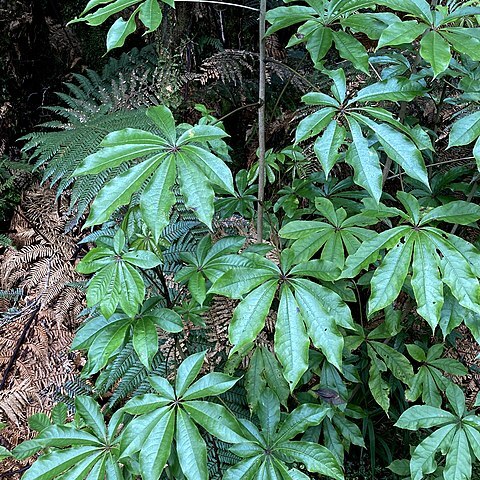Trees or lianes, often epiphytic or possibly epiphytic at first and independent later. Leaves petiolate, digitately compound; leaflets subentire to crenate. Stipules intrapetiolar, often connate with petiole for some distance. Inflorescences paniculate, with flowers ultimately in umbellules, fascicles or capitula; pedicels (where present) not articulated beneath the flower. Calyx-margin repando-dentate to subentire. Petals 5–10, sometimes calyptrate (being shed as a cup) or opening on flower. Stamens equal in number to the petals. Disk flat, depressed or conically raised. Ovary 5–8-locular; styles equal in number to the locules, connivent at base. Fruit ± subglobose or ovoid. Seeds laterally compressed, ellipsoidal, smooth; endosperm nonruminate.
Shrubs or trees, sometimes climbers or epiphytes, evergreen, hermaphroditic or andromonoecious, unarmed. Leaves palmately compound, rarely unifoliolate (not in China), margins entire to serrate; stipules united within petiole. Inflorescence a terminal or pseudo-lateral panicle or compound raceme; flowers arranged in umbels, heads, or racemes; bracts pubescent, deciduous or persistent. Pedicels not articulate below ovary. Calyx rim entire or 5-toothed. Petals 5-11, valvate. Stamens 5-11. Ovary (4 or)5-11-carpellate; styles partly or completely united into a column or stigmas sessile. Fruit a drupe, globose or ovoid. Seeds (4 or)5-11, laterally compressed; endosperm uniform or slightly ruminate.
Plants polygamous or dioec., us. in umbels scattered racemosely along the branches of a panicle. Calyx-teeth minute or obsolete; petals 5 or more, valvate; stamens same number as petals. Disk large, undulate-margined, ovary 5-or more-loculed; style-branches same number as locules, connate below. Fr. fleshy, seeds one per locule. Shrubs or small trees. About 150 tropical and subtropical spp. The N.Z. sp., type of the genus, is endemic.
Inflorescence a panicle of umbellules or of umbellules racemosely arranged on a main axis (capitulate in some species outside the F.Z. area).
Ovary with (2)5–8 locules, the styles prominent and equalling the locules in number, joined at the base and spreading above.
Leaves digitate, long-petiolate; leaflets entire to slightly serrulate or crenulate; stipules often conspicuous.
Flowers with 5–10 petals which may be functional or shed as a calyptra as the flower opens.
Articulation present between petiole and blade Styles or stigmas more than 2
Seeds laterally compressed, ellipsoid, smooth, with non-ruminate endosperm.
Shrubs, trees or lianes, sometimes occurring as epiphytes.
Disk flat or slightly raised in the F.Z. species.
Stamens equal in number to the petals.
Fruit subglobose to ovoid.

